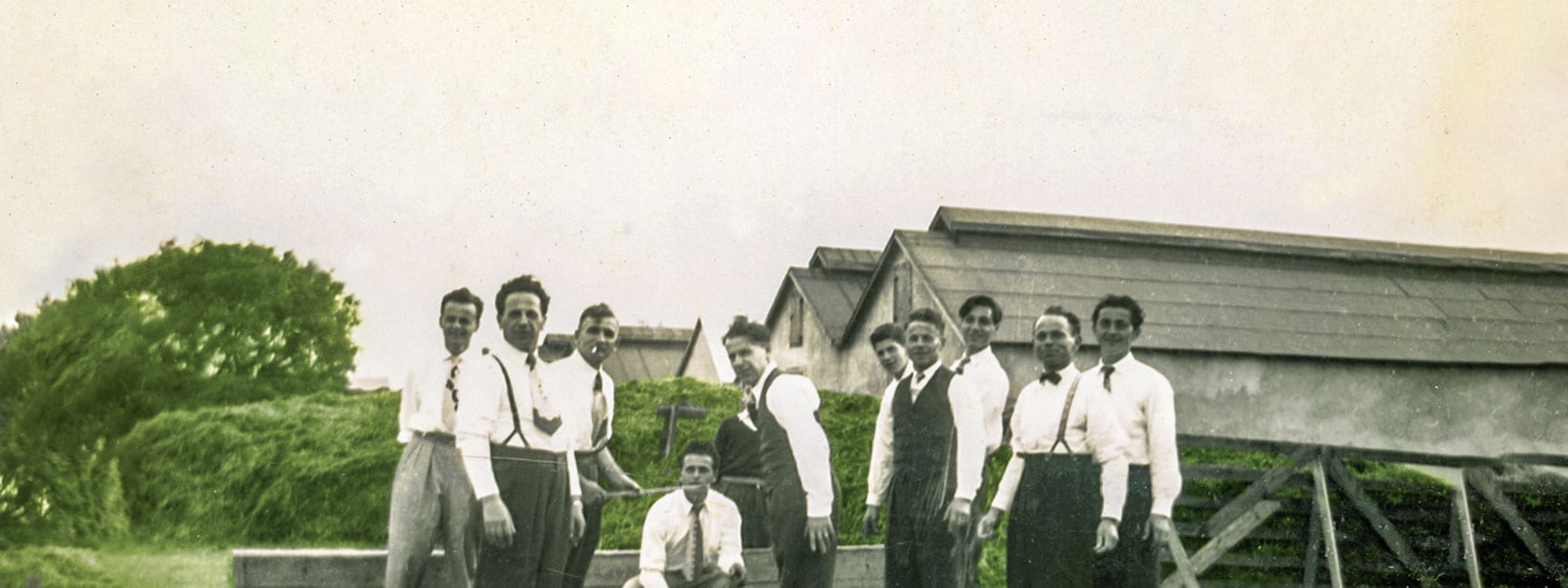Joey Votto
Written by Nathan Laird
Growing up playing baseball in Canada, Joey Votto was my Wayne Gretzky. His stories of taking pretend swings in the garage during the winter, or throwing a baseball against the school wall are relatable on a personal level (Elliot, 2018). He was living proof that a kid from a northern climate can not only make the professional level, but excel once arriving.
Votto was born in the city of Etobicoke in 1983 (Baseball Reference, 2020). He grew up going through the regional baseball system that was in place at the time (Pierson & Castleberry, 2019). Due to a lack of exposure, Votto was a relatively-unknown prospect coming out of high school; in fact, he was discovered by accident. When his local Etobicoke club entered into a oneoff tournament in Florida, a scout for the Cincinnati Reds was at the game watching a relative who played on the opposing team. When he saw Votto swing the bat for the first time, it immediately caught his attention. Several follow-up trips to Canada with other scouts from the organization were conducted, eventually leading to the Reds selecting Votto 44th overall in the 2002 Major League Baseball (MLB) draft.
Votto was known to be a risky selection due to his lack of experience and competition (Pierson & Castleberry, 2019). But this high risk yielded a high reward. He has since emerged as one of the MLB’s top players, winning awards as Canada’s Top Athlete and MLB MVP in the process (Sportsnet Press, 2017). As Votto’s success grew, so did his popularity within Canadian baseball circles. Having great success comes great responsibility in the public eye. As a Canadian baseball icon, Votto involuntary took on the duty of appropriately representing not only his personal brand, but Baseball Canada as well. Thus, when Votto asked to give his thoughts on Canadian baseball, it shocked many when he took a critical tone. Instead of utilizing his platform to uplift the reputation of Canadian baseball, he quite candidly criticized it. He explained how he didn’t care at all about the state of the game in his home nation as it was his neighbouring country of the USA that birthed all of his baseball related opportunities (Williams, 2018).
When people within the baseball circles of Canada heard Votto’s comments, shock was the immediate reaction. A man who was once looked at by most fans as a superhero instantly changed face to public enemy number one. The rationale behind Votto’s comments were extremely confusing as the contradict countless previous examples of publicly displayed kindness and national pride (Elliott, 2018). While many fans decided to “cancel” Votto, I saw his comments from a slightly different perspective. I was inspired to dig deeper to determine the true motives behind his condescending remarks. I investigated the contrasting systems both at the youth baseball level all the way through the college level to understand which pathway leads to the most opportunity. Understanding that there are always other extenuating factors that play influence on opportunity, I tried to account for other demographics that could have an impact on a prospect realizing their full potential.
To further understand Votto’s viewpoint on the lack of that exists for Canadian baseball players domestically, I began to gather statistics that compared the number of Canadians playing professionally to the number of players reigning from other geographic centres. The results were stunning. Out of the 571 players in the MLB last year, only 10 were born in Canada (Gough, 2020).
In an attempt to compare the present to the future, I tallied the system in which each of the draft picks in the 2020 draft hailed from. Out of the 190 draft picks, 144 of them were selected out of the university-level. All 144 picks came out of the American post-secondary organization the NCAA with none coming out of the Canadian league of USPORTS. The remainder of the selections were taken at the high school level; with only 2 of which selected out of Canadian high school (Rivera, 2020). I realized that neither player participated in a high school league; which greatly contrasts the American mindset where high school baseball is prominent. This meant that the two selections from Canada would have had to have played in an organization outside of school to gain recognition from professional scouts.
Growing up playing baseball in the Ontario system, there were three options available: to play in a local recreational league, play on the cities competitive team who competed against others in the area, or join on with an “elite travel team” that prioritized exposure south of the border and enhanced daily training year-round. For the purpose of the study, I decided to omit the recreational level to focus on the levels which breed future prospects. Votto comes from a background of playing regional baseball where the other nine current professionals came through various elite programs.
The two systems contrast substantially from one another with cost being a main differentiating factor. On a regional team, the team budget gets equally divided amongst the members on the team. A season of baseball costs between $1,000-$4,000, with the variability stemming from the number of tournaments and extra events and training the team chooses to implement (Doucet, 2015). Minimizing costs is a priority as local systems are not for profit. Elite systems, on the other hand, are run as a business where profits need to be maintained. Costs range anywhere from $3,500-$13,000, where the strongest players pay on the lower scale where the weaker links pay on the higher scale (Maclean, 2020). Critics of elite baseball argue that the high costs associated with elite baseball are equivalent to the costs of yearly Canadian tuition, which mitigates the incentive of receiving scholarship money south of the border. Other rebuttal that although this may be true, it is also the path which gives their kid the best chance at reaching their full potential and experiencing success; which is what the majority of parents want for their children. Elite teams go to five scouted tournaments a year. This gives scouts the opportunity to gain more than one look at an intriguing player. Additionally, the elite programs all possess strong connection with baseball Canada’s Junior National Team who gets scouted the heaviest. Of the 10 current Canadians in the MLB, all for the exception of Votto played on this team (Elliott, 2018). Looking at the most recent roster this year, all thirty players hail from elite programs.
The greatest differentiator comes with regards to the quality of competition. In regional leagues, the overall skill level tends to be lower than elite. There are usually a handful of players on these teams who stand out amongst their peers where in the elite systems there is more depth top to bottom (Pierson & Castleberry, 2019). In cases like Votto’s, performing well in a regional league still leaves doubt in scouts minds as there is an element of risk attached to the adaptation to playing against enhanced competition. On elite teams, not only is the domestic competition greater, but travelling South of the border ensures that they are getting constant gameplay against top American talent which is highly sought after at the high school level. Regionally, teams practice 3-4 times a week seasonally, whereas elite teams stay busy year-round. Due to this enhanced commitment, elite players have a greater opportunity to enhance their skillset. When the climate becomes a restrictive factor, elite teams possess an indoor facility in which their athletes to train through the winter. As Votto describes, many regional kids don’t have these resources available and are forced to utilize DIY training mechanisms to improve (Sportsnet Staff, 2017).
This brings up another interesting dimension to the case: why is it that Canada as a country gets passed over to such a significant degree? I investigated how the scouting structure is set up in professional organizations. I discovered that out of an entire scout team, there is usually only one scout devoted to the country of Canada (Pierson & Castleberry, 2019). When you take into consideration that nearly 80% of a team’s scouting department stems from geographic locations across the USA, not only does it explain the high volume of American born players in the MLB; but it also provides explanation to why so many Canadian baseball players make the decision to play on elite baseball teams that have connections to people of interest south of the border (Lindbergh, 2019).
This brings me back to the controversy. At face value, Votto’s comments appear to be rooted in unexplainable and unjustified animosity. Although the delivery of his message could been executed differently, it is hard to question his character and love for Canada. Votto has never been one to demand the spotlight, he has always let both his game and actions do the talking (Elliott, 2018). This is exemplified in his continuous displays of national pride, charity work, and well as recognition as being voted as the nicest player by his opponents (Brisbee, 2017). The only time Votto is said to break his action-based persona is when he is questioned on topics that have a great deal of meaning to him. Thus, when a comment like this is made, it is clear that there was a motivating factor of some sort that sparked a blunt remark. Additionally, like any good Canadian, Votto reflected on his remarks and took the time to deliver a heartfelt apology for the sharpness of his comments (Elliott, 2018)
After conducting in-depth analysis on the current pathways of opportunity for Canadian-born players, it appears that he may have been utilizing his platform to make a purposeful political point. He understands that he was overlooked for choosing to play locally over elite and was therefore limited in exposure aiding resources. Therefore, I think Votto used his platform to speak on behalf of those current and future players who have the same narrative as him without getting the big break. The goal of these remarks was not to hinder the reputation of Canadian baseball, but instead enhance it over time by pressuring them to review the system currently in place.
As a next step, I think it would be very interesting to interview Votto and attempt to (respectfully) get very candid about what his viewpoints are; and in what way he thinks positive change can be realized. It would be interesting to bring all players of interest into a room and conduct a conference where opinions and perspectives can be shared. The goal would be to brainstorm ways to create a system where next generation youth baseball players feel they can realize dreams domestically. As a continuation, I would interview a higher volume of coordinators a both the regional and elite levels. I would ensure that data is collected from other areas of Canada as well.
December 2020
Bibliography
Brisbee, G. “Joey Votto hit a home run and gave his jersey and bat to a kid.” 31 August 2017. https://www.sbnation.com/2017/8/31/16235978/joey-votto-jersey-bat-kid.
C., Press, C., & Staff, S. “Reds slugger Joey Votto wins Lou Marsh award as Canada’s top athlete.” 12 December 2017. https://www.sportsnet.ca/baseball/mlb/reds-slugger-joey-votto-wins-lou-marsh-award-canadas-top-athlete/.
Doucet, B. “Is elite baseball a money grab?” 6 September 2015. https://www.cambridgetimes.ca/community-story/5829110-is-elite-baseball-a-money-grab-/.
Elliott, B. “Bob Elliott’s Baseball: Joey Votto’s actions have always spoken louder than his words” | CBC Sports. 17 May 2018. https://www.cbc.ca/sports/baseball/mlb/joey-votto-apology-bob-elliott-1.4667643.
Gough, C. “MLB players on opening day rosters 2013-2020.” 28 August 2020. https://www.statista.com/statistics/639334/major-league-baseball-players-on-opering-day-rosters/.
“Joey Votto Stats.” https://www.baseball-reference.com/players/v/vottojo01.shtml.
Lindbergh, B. “The Evolution of MLB Scouting Is a Threat to the Profession Itself.” 8 March 2019. https://www.theringer.com/mlb/2019/3/8/18255453/cincinnati-reds-scouting-reports-series-part-3.
Pierson, P., Castleberry, J., Scherrer, B., & Votto, J. (2019, August 27). “Joey Votto’s incredible journey to the Reds.” 27 August 2019. https://www.mlb.com/news/featured/joey-votto-s-incredible-journey-to-the-reds.
Rigakos, G. “A Beginner’s Guide to University Baseball in Canada.” 2017. https://www.curavensbaseball.com/a-beginners-guide-to-university-baseball-in-canada/.
Staff, B. “Joey Votto took batting practice in a Black Lives Matter shirt” – Article. 7 July 2020. https://www.bardown.com/joey-votto-took-batting-practice-in-a-black-lives-matter-shirt-1.1493079.
Staff, M. “Opening Day rosters feature a record 291 internationally-born players.” 24 July 2020. https://www.mlb.com/press-release/press-release-mlb-opening-day-rosters-record-internationally-born-players.
Williams, R. (2018, June 04). “Offside.” 4 June 2018. https://dailyhive.com/vancouver/joey-votto-apologizes-insulting-canada-2018.
Written By Joe Rivera @JoeRiveraSN, Written By Joe Rivera, By, W., & Rivera, J. “MLB Draft results 2020: Complete list of picks for Rounds 1-5 in baseball draft.” 12 June 2020. https://www.sportingnews.com/ca/mlb/news/mlb-draft-tracker-2020-live-results-picks/tgnjiichf1s717wbm4vs6fher.
How to cite this page:
MLA STYLE: Author. “Title.” Title of container, Other contributors, Number (vol. and/or no.), Publisher, Publication Date, Location (pages, paragraphs and/or URL, DOI or permalink). 2nd container’s title, Other contributors.
Laird, Nathan. ”Joey Votto.” In Archival Research of Italian-Canadian Immigration and Culture, supvr. T. Russo, issue 4: Italian-Canadians as Athletes and Community Builders: Contributions in the Sports Industry, Brock University, December 2020, St. Catherines (Sports in Italian-Canadian Communities – Italian-Canadian Narratives Showcase (italianheritage.ca)). Italian-Canadian Narratives Showcase (ICNS), Sandra Parmegiani and Nivashinee Ponambalum.


